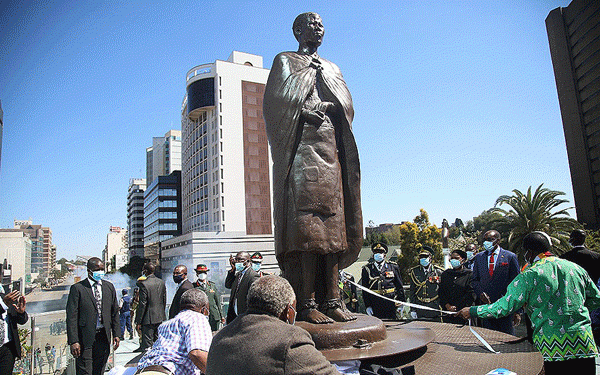
Miriam Tose Majome THE unveiling of the Mbuya Nehanda statue at the intersection of Samora Machel Avenue and Julius Nyerere Way in Harare, was one of the most disappointing events on the 2021 Harare arts calendar.
As historic monuments go, it is one of the most underwhelming pieces of public art ever created. Its tiny size among the massive steel frame which girds it is its most distinguishing feature, not to mention discouraging and disappointing.
Far-sighted people can barely make it out among all the steel frames that surround it. It is a mediocre unimpressive life-size figure atop an imposing maze of steel. There is more permanent scaffolding than statue. Harare endured nearly a year of inconvenience during its construction at the intersection of what must be the busiest roads in the city where Julius Nyerere Way meets Samora Machel Avenue.
Samora Machel Avenue is busy because it is the symbolic threshold that divides Harare between the more prosperous northern parts and the more povo-friendly southern parts.
The late musician Oliver Mtukudzi, in a moment of ecstasy circa 1985/6 composed a song called “The Avenue Samora Machel” when it was renamed from Rhodes Avenue. A road with a song in its honour surely deserves a grander and more show-stopping monument.
For the greater part of 2021, Harare residents and visitors aged noticeably in excruciating traffic jams because major roads were closed as workmen laboured slowly and forever at the construction site. The massive steel frame is a four-way pedestrian footbridge which meets at the summit where the statue sits. President Emmerson Mnangagwa unveiled it in May 2021 to much aplomb and ceremony, but it was not what was expected, especially for the time it took to complete. Alas, it was but a life-size unimpressive figurine.
The idea to commemorate the country’s most recognisable spiritual symbol of black independence is undisputed. Most black Zimbabweans agree that something needed to be done to immortalise the image of Mbuya Nehanda. The only issue with some people was its prioritisation among the country’s other pressing needs. Its unveiling was anticipated by supporters and critics alike.
Unfortunately, it failed to live up to its billing. The designers and engineers could certainly have done better for the cause of monumental city architecture.
- Chamisa under fire over US$120K donation
- Mavhunga puts DeMbare into Chibuku quarterfinals
- Pension funds bet on Cabora Bassa oilfields
- Councils defy govt fire tender directive
Keep Reading
Unwittingly, the statue brought out many things that are wrong with Zimbabweans among them our disunity, inefficiencies and mediocrity. If pressed to find just one positive thing to say it would be that the statue has a rather clever rotating plinth which enables it to slowly turn 360 degrees to face all the sides of the city.
Not every Zimbabwean accepts the significance of Mbuya Nehanda and her place in history. That is fair and expected but the one thing any public monument which occupies the heart of a capital city should do is impress even the most ardent critics and uninterested people. Statues should attract attention and trigger some reaction or emotion, be it positive or negative.
A statue that is neutral and unremarkable is a failure. The majority of people who encounter a statue should feel something or at the very least notice it. It should move something by its significance or beauty or at the very least its size and presence and its command of physical space. The argument that the statue could not be too imposing lest it be too heavy for its supporting frame reflects laziness and dearth of imagination and resourcefulness. It does not take a scientist or engineer to figure out that it could have been made using suitable light material that could be large yet without encumbering the frame. The people deserved something better and grandeur, not that barely visible doll atop a ubiquitous steel structure.
The statue adds absolutely nothing valuable to the architectural art history of Harare. It is a monumental waste of an opportunity to put Harare on the African art map at the very least. Done properly and right, it would have been a tourist attraction for which people from other towns in the country and art critics from all over the world would have been prepared to travel to Harare just to marvel at. Americans and other people from within and outside America visit New York City just to see the Statue of Liberty. Thousands of people are drawn to Europe from all over the world just to see iconic human-made monuments like the Basilica, the Eiffel Tower, the Pantheon and many others.
The Nehanda statue given her history was a chance that went begging to create contemporary art history. Perhaps going up close and standing directly beneath the statue could evoke something, but for an unknown reason people are forbidden from going up the footbridge to see it up close as it was designed.
Public monuments play a significant role in imprinting a permanent memory on the landscape and marking the political history clock. Statues and monuments mark time more than any other tangible symbol. Statues are erected and taken down all the time in the course of history. The images of the dismantling of Lenin monuments in Ukraine and other parts of the former Soviet Union marked the end or rejection of Soviet rule, the tearing down of Saddam Hussein’s statue during the 2003 invasion of Baghdad by the Allied Forces or the removal of Rhodes’ statue at the University of Cape Town by South African students during the “Fees Must Fall” campaign in 2015 are all memorable events in history. The unending debates about the confederate statues in the US and the colonial and slave era monuments in Britain are also included.
Erecting statues and tearing them down marks either the beginning or end of eras. Their presence or absence significantly alters the landscape and architecture of a place, so they should at least be artistically remarkable while they are there.
The Mbuya Nehanda statue has permanently transformed the Harare landscape and will be there for a long time to come. That is the reason it should have been done in a way that added value to the city’s real estate and the intangible feeling of ownership and pride by the city’s residents.
The success of public monuments lie in their ability to evoke some kind of emotion — positive or negative. Salisbury (now Harare) had its fair share of colonial-era statues which immortalised and glorified colonial conquest.
The most interesting and controversial of them is called Physical Energy which is a replica of an original British statue. It is a massive bronze behemoth depicting a rider in control of a gigantic horse in powerful motion.
Looking up at it one cannot help but feel brute power and force frozen in solid bronze. It was presented as a gift to the Federal Rhodesian Government in 1960 by the British South Africa Company in memory of Cecil Rhodes. It symbolised the relationship between the white settlers and the indigenous black people — the white man being the rider and master in control of the black people depicted by the horse.
Needless to say it was much revered by some white people and thoroughly hated by black people who knew the symbolism. For all its grandeur, it was quite controversial.
The colonial governments between Lusaka and Salisbury never really knew what to do with it that it was shuttled back and forth between the two countries at different points in history.
Its final resting place is among scraggly weeds behind the National Archives in Harare gathering moth and dust together with the collection of other legally-protected colonial era relics.
Obviously no right-thinking black African can affiliate with the Physical Energy statue but everyone who encounters it is forced to look at it.
Even if one is unaware of its symbolism, they will marvel and admire its majesty and dominance. Unfortunately, one does not get that feeling of awe with the Nehanda statue.
Even if one understands its historical significance and supports its construction, the statue speaks nothing, inspires nothing and triggers nothing.
The statue may be firmly in place, but the debate about it is far from over.
- Miriam Tose Majome is a lawyer with Veritas. She writes here in her personal capacity and can be contacted on [email protected].











